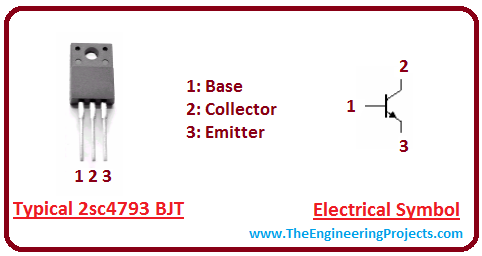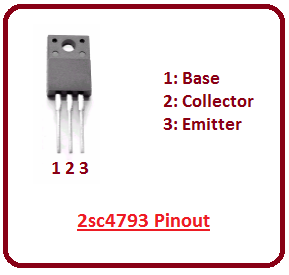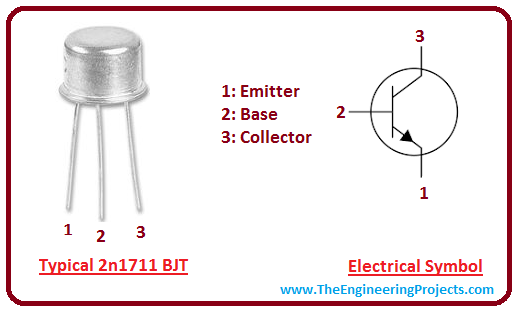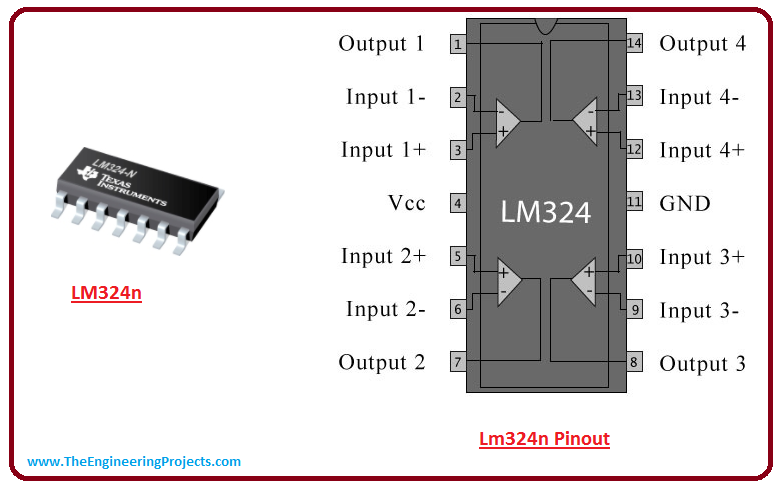

Introduction to 2sc4793


Introduction to 2sc4793
- 2sc4793 is an NPN bipolar junction transistor where P-doped layer is sandwiched between the two N-doped layer.
- It is mainly three terminal device which comes in TO-220F package and exhibits high transition frequency.
- Three terminals are called emitter base and collector.
- P layer of this transistor is behaved like a base while other two N layers represent collector and emitter receptively.
- As it is an NPN transistor, so base is positive with respect to emitter.
- It is a current controlled device where small current at the base side is used to control the large amount of current at the emitter and collector side.
- Unlike FETs(Field effect transistors), it is a bipolar device, where conduction is carried by the movement of both charge carriers i.e. electrons and holes.
- Sometimes you can see these transistor separated but most of the time they are incorporated in tiny integrated circuit.
- This transistor is widely used in many electronic application but mostly it is used for amplification and switching purpose.
2sc4793 Pinout
2sc4793 bipolar junction transistor mainly consists of three terminals.
- The small current at the base side is used to control the large current at the collector and emitter side.
- The ability of base current to control emitter and collector current is used for amplification purpose.
- This silicon transistor is mainly remained in ON state when current flows from emitter to collector.
Circuit Diagram of 2sc4793
Following figure shows the circuit symbol of 2sc4793.
- As it is an NPN transistor, so base is positive as compared to emitter.
- In most NPN transistors, emitter side is heavily doped because its job is to emit number of electrons while base side is lightly doped because its job is to control the number of electrons emitted from the emitter side.
- These injected electrons are then collected by the collector. Hence, base controls the overall conductivity of the path between emitter and collector.
- Forward current gain of this transistor can be represented as Beta ß.
- It is a ratio between collector current and base current and it exhibits no units.
- Sometimes it is referred as a amplification factor because small change in base current causes a large change in collector current.
- Beta value ranges between 20 to 1000. Standard value in most of the cases is 200.
- The current gain of the transistor is represented by alpha a and it is a ratio between collector current and emitter current.
- Alpha value of transistor ranges between 0.95 to 0.99, however in most of the cases alpha value is considered as one.
- When voltage is applied at the base side, it gets biased and allows the current to flow from emitter to collector.
- When there in no voltage at the base side, transistor will be OFF, in case of positive voltage at the base, transistor is considered as ON.
Absolute Maximum Rating of 2sc4793
Absolute maximum rating of 2sc4793 is shown in the figure below.
- Both, collector-base and collector-emitter voltage are 230 V. Collector current is 1 A and base current is 0.1 A. Maximum power it can dissipate is about 20 W.
- These are the standard stress rating. Values above these standard operating conditions can damage the device and can effect device reliability.
Applications
- 2sc4793 is widely used in many electronic circuits as a voltage and power amplifiers.
- It is also used as switch in most circuits, because it exhibits high transition frequency.
×
![]()








 1 user
1 user






 Continue Wishlist
Continue Wishlist





 Getting Started Guide
Getting Started Guide
 Help Center
Help Center
 Contact us
Contact us
 Doist Blog
Doist Blog
 Privacy
Privacy
 Security
Security
 Terms of Service
Terms of Service
 What's new: Channel Descriptions
What's new: Channel Descriptions





 Electronic Components
Electronic Components adnanaqeel
adnanaqeel 0 Comments
0 Comments








 2.3k
2.3k
 953
953
 921
921
 2.1K
2.1K
 introduction to 2sc4793
intro to 2sc4793
working of 2sc4793
basics of 2sc4793
introduction to 2sc4793
intro to 2sc4793
working of 2sc4793
basics of 2sc4793

 Thursday, February 8, 2018
Thursday, February 8, 2018
























